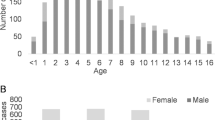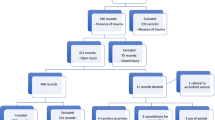Abstract
Background
Cairo university hospitals are at the heart of Cairo with close proximity to Tahrir (Liberation) square and had received the vast majority of casualties during the Egyptian revolution. The aim of this study was to analyze the eye injuries during the uprising.
Design
Retrospective cohort study.
Methods
Data were obtained from patients’ paper records, interview with treating ophthalmologists, and whenever possible patients were interviewed and examined. An electronic medical template had been specially developed for recording these data. Main outcome measures were the flow of patients and their demographics, diagnoses, visual acuities pre and post interventions, investigations and management. Whenever required results were compared at 95 % confidence interval.
Results
There were 184 patients (mean age 27.3 ± 9.6 years) with 195 injured eyes of whom 96.7 % were males and 11 patients had both eyes injured. Seventy seven percent of patients had been admitted within 24 h of injury. Open globe injuries comprised 87 % of the eyes of which 147 eyes received 259 imaging investigations. The presenting visual acuities were worse than 3/60 in 72.5 % of eyes which were even worse post interventions and that was significantly dependent on the presenting vision. Wound repair was the primary intervention in 85 % of eyes while 50 % of the secondary interventions were vitrectomies.
Conclusions
Presenting visual acuity is a valid prognostic factor in the setting of mass eye casualty. Management of open globe injuries continues to pose difficult challenges especially bilateral ones.



Similar content being viewed by others
References
Waeckerle JF (1991) Disaster planning and response. N Engl J Med 324:815–821
Flint L (2008) Trauma. Contemporary Principles and Therapy. In: Meredith JW, Schwab CW, Trunkey DD, Rue LW, Taheri PA (eds) Lippincott Williams & Wilkins, Philadelphia PA, pp 9–21
Almasry-alyoum (2011) Health offices documented the fall of 840 martyr during the revolution of 25 January. Retrieved 04-04, 2011, from http://web.archive.org/web/20110429125656/http://www.almasryalyoum.com/node/385140
Negrel AD, Thylefors B (1998) The global impact of eye injuries. Ophthalmic Epidemiol 5:143–169
Pieramici DJ, Au Eong KG, Sternberg P Jr, Marsh MJ (2003) The prognostic significance of a system for classifying mechanical injuries of the eye (globe) in open-globe injuries. J Trauma 54:750–754
Soliman MM, Macky TA (2008) Pattern of ocular trauma in Egypt. Graefes Arch Clin Exp Ophthalmol 246:205–212
Jaouni ZM, O’Shea JG (1997) Surgical management of ophthalmic trauma due to the Palestinian Intifada. Eye 11:392–397
Colyer MH, Chun DW, Bower KS, Dick JS, Weichel ED (2008) Perforating globe injuries during operation Iraqi Freedom. Ophthalmology 115:2087–2093
Rahman I, Maino A, Devadason D, Leatherbarrow B (2006) Open globe injuries: factors predictive of poor outcome. Eye 20:1336–1341
Acknowledgments
The authors would like to thank the following ophthalmologists for participating in collection of data: Rasha AbdAllah, Ola ElSheikha, Heba Makled, Lameece Hassan, Karim Bakr, Mohamed Beshr, Mohamed Attia, Mohamed Khafagy, Heba Magdy, Ayman Rashed, Dina Abdelmenam, Mohamed Sabry, Khaled Elhusseiny, Dina Hossam, Mahmoud Osama, Ramy Reyad and Malak Adly.
Conflict of interest
No conflicting relationship exists for any author.
Financial support
None
Author information
Authors and Affiliations
Corresponding author
Additional information
This article has not been published anywhere previously and that it is not simultaneously being considered for any other publication.
Rights and permissions
About this article
Cite this article
Eldaly, M.A., AbdelHakim, M.A., Zaki, R.S. et al. Eye trauma during the 2011 Egyptian revolution. Graefes Arch Clin Exp Ophthalmol 251, 661–665 (2013). https://doi.org/10.1007/s00417-012-2202-6
Received:
Revised:
Accepted:
Published:
Issue Date:
DOI: https://doi.org/10.1007/s00417-012-2202-6




